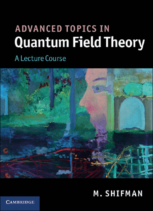Theory: A Lecture Course
By M Shifman
Cambridge University Press
Hardback: £45 $80
E-book: $64

Many interesting developments have taken place in quantum field theory (QFT) since the 1970s, and there is no better place to learn about them than this book. The author has been an active contributor to the field over the past four decades and he has produced a personal book based on his lectures over the years. Reading the table of contents virtually gives you vertigo because the depth and breath of the topics covered is simply staggering.
The book is structured as two parts: before and after supersymmetry – although many of the concepts introduced in the first part have an extension in the supersymmetric context, with interesting conceptual variations. All subjects are treated thoroughly and with great clarity. The opening chapter deals with the important subject of the phases of gauge theories and it continues with the many exotic objects that populate QFT, namely kinks, domain walls, strings, vortices, monopoles, skyrmions, instantons, chiral anomalies, confinement, chiral-symmetry breaking and a quick overview of lower-dimensional models related to the theory of phase transitions. The treatment of each subject is rather complete, and many difficult subjects are explained with exemplary clarity, for example the use of collective co-ordinates and their importance in the quantization of semiclassical states, as well as the interplay between chiral-symmetry breaking in QCD-like theories and confinement.
The author provides one of the most elegant and concise presentations of the use of instantons in gauge theories that I have ever seen. This is a notoriously complex subject, with important physical implications, such as the vacuum angle in QCD and the strong CP problem. The computations are carried out in detail and the reader is led by a safe hand through all of the delicate aspects of rather complex calculations. This is a great service to anyone trying to learn advanced QFT after a grounding in the standard courses in the subject.
In the second part of the book, the author provides a remarkably lucid and complete presentation of supersymmetry, supersymmetric gauge theories and all of their associated phenomenology. It is difficult to pack more information in the 150 pages dedicated to the subject. The phase diagram of supersymmetric gauge theories is rather complex and subtle. There is no one better suited than the author to introduce the subject; he has been one of its main contributors over the years. Subjects such as supersymmetry anomalies, the Witten index, the implications and uses of instantons within supersymmetry, the super-Higgs mechanism and the Russian beta-function are but a few of the subjects featured in this part of the volume.
This book is a must for anyone interested in learning about the developments in advanced field theory over the past few decades. It is a pedagogical and deeply insightful presentation by one of the masters in the field.





